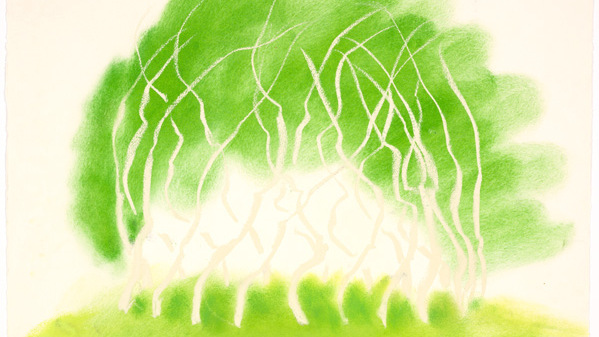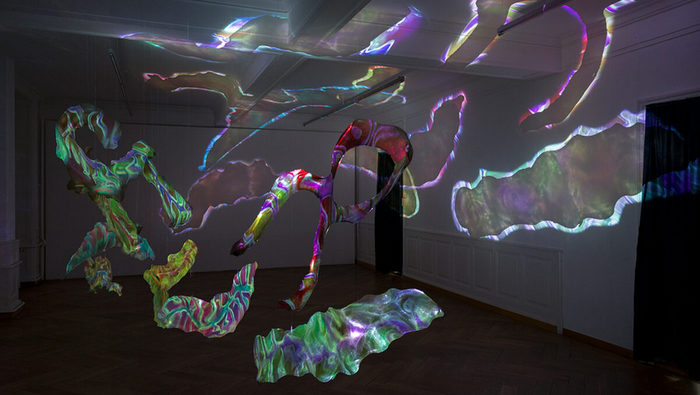For their first museum exhibition, Sirah Foighel Brutmann & Eitan Efrat created their project Là, a multifaceted critical work that represents a reconciliation with the death of Belgian director Chantal Akerman on the one hand, and, on the other, with the impossibility of being able to communicate with her after her death.
Brussels-based artists and filmmakers Sirah Foighel Brutmann (°1983) and Eitan Efrat (°1983) produced their new project Là for their first museum exhibition. The title affectionately refers to Là-bas, the 2006 film by Belgian director Chantal Akerman (1950 - 2015). Phonetically, Là (meaning 'there' in French) means different things in Arabic and Hebrew. In Arabic, لا means no (the negation of hegemonic narratives on the land). In Hebrew, לה means for her (a tribute or a sort of offering to Chantal Akerman). Là simultaneously represents a continuation of Brutmann and Efrat’s imaginary dialogue with Chantal Akerman and an audio-visual journey between Belgium and the Negev/al-Naqab desert in Israel/Palestine, whilst examining the belief of belonging through natural elements and historical accountability.
One of the exhibition’s cornerstones is Akerman’s last film No Home Movie (2015). In many respects, this film signifies the culmination of the intense triangular relationship between Akerman, her mother, and Brussels. Là draws its roots and inspiration in the opening shot of No Home Movie, which shows a tree struggling against the fierce desert wind against a backdrop of spectacular desert hills stretching up to the horizon. This shot and four others – which also feature in No Home Movie – is intended to be understood as a generic desert, i.e., “any desert”. The elastic landscape serves as a crucial, decisive counter-shot to the claustrophobic Brussels apartment of Akerman’s mother dominating the rest of the film. When Sirah Foighel Brutmann and Eitan Efrat watched the film, they were moved by the familiarity of this particular desert that Akerman shoots in such a way as to give spectators enough time to observe and be immersed in this landscape. Yet, unlike other viewers, Brutmann and Efrat traced the exact location of this supposed “generic image” in Israel/Palestine, an information not credited as a location in Akerman’s film. The second desert shot in No Home Movie is a tracking shot filmed from a car window. This shot exposes us to its precise location as the road between the Israeli city Arad and the Masada archaeological site. The second place in Akerman’s filmed shot is an unmarked road off the main road extending beyond the desert hills. This particular road leads to the unrecognised Bedouin village of Al-Buqayʿah, akin to the many others that Israel has tried – and in many cases succeeded – to eradicate since its creation in 1948.
With Là, Brutmann and Efrat take a close look at the desert environment along the road where Chantal Akerman filmed No Home Movie in 2015. Là looks at how the landscape is shaped by colonial practices on the land, including depriving Bedouin villages from water and electricity, while creating artificial oasis for pilgrims and tourists. In the same environment, trees imported by the British and Zionists from across the British Empire (such as for instance, the eucalyptus brought from Australia and Tanzania), are being irrigated from distant water sources. The exhibition takes the time to focus on the resilience of plants to desert wind, drought, repeated floods, and heat, giving the opening shot of Akerman’s No Home Movie a particular context.
Là is genuinely a multifaceted critical work that represents a reconciliation with Chantal Akerman’s death on the one hand, and, on the other, with the impossibility of being able to communicate with her after her death. Drawing on the work of Emmanuel Levinas, Jacques Derrida, and Akerman (including her writings), the exhibition engages in an imaginary dialogue with Akerman as a way to grieve. The artists lament at the world left behind by Akerman: Là is a reassessment of the European Jewish accountability to Israel and the ongoing Palestinian Nakba from a post-Zionist perspective, in line with the rich history of Belgian Jewish anti-fascist movements from both communities. Primarily featuring new artworks, Là produces an experimental audio-visual environment where the production and presentation processes and mechanisms of moving images and sound feature spatially and expansively to invoke a layered perception of place.
Biography Sirah Foighel Brutmann (°1983) and Eitan Efrat (°1983):
Sirah and Eitan live and work in Brussels, where they work together to create audio-visual pieces, installations, and performances.
Their artistic practice focuses on the performative aspects of moving images. They strive to mark the spatial and durational potentialities of reading still or moving images, the relations between spectatorship and history, the temporality of narratives and memory, and the material surfaces of image production.
Their work has been shown in duo exhibitions in Kunsthalle Basel (CH); Argos, Brussels (BE); CAC Delme (FR); Brakke Grond (NL). They have taken part in group exhibitions in the Wiels (BE); Museum für Kunst und Gewerbe, Hamburg (DE); Portikus, Frankfurt (DE); Jeu de Paume, Paris (FR); and STUK, Leuven (BE). They have participated in such film festivals as EMAF, Osnabrück (DE); Atonal, Berlin (DE); Doc Lisboa (PT); Oberhausen Film Festival (DE); Rotterdam Film Festival (NL); Les Rencontres Internationales, Paris and Berlin (FR/DE); New Horizons, Wrocław (PL); Images, Toronto (CA); 25FPS, Zagreb (HR).
Currently, Sirah and Eitan teach at Brussels’ ERG, and are members of the artist collective Messidor, along with Meggy Rustamova and Pieter Geenen, as well as members of Level Five, an artist-run cooperative studio in Brussels.
Refusing any form of monetary transaction with government-subsidised institutions in Israel, Sirah and Eitan support the struggle for the liberation of the Palestinian people in Palestine and around the world.
SIRAH FOIGHEL BRUTMANN & EITAN EFRAT. LÁ
6 APRIL–8 SEPTEMBER 2024
S.M.A.K | GHENT, BELGIUM
Source: S.M.A.K.
Related Publications

Galerie Lelong & Co. | David Nash
November 22, 2024(S)elf Portraits: Fiction, Fantasy, and Sci-Fi in Portrait
November 18, 2024
Auswahl 24- Guest artist: Victoria Holdt
November 15, 2024










